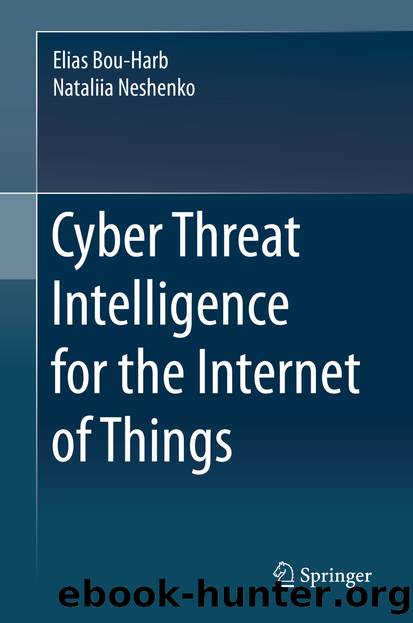Cyber Threat Intelligence for the Internet of Things by Elias Bou-Harb & Nataliia Neshenko

Author:Elias Bou-Harb & Nataliia Neshenko
Language: eng
Format: epub
ISBN: 9783030458584
Publisher: Springer International Publishing
2.9.1 Vulnerability Assessment
Executing security evaluations undoubtedly aids in discovering IoT vulnerabilities prior to them being exploited. Various methods ranging from testbeds to attack simulation and fuzzing techniques have been decisive in obtaining effective and actionable information related to the cyber threat posture of the IoT paradigm.
A research direction in this area focuses on designing new testbeds or adopting existing methods to perform IoT vulnerability assessment. One of such testbeds, which utilize a number of open source software such as Kali Linux, Open VAS, Nessus, Nexpose, and bindwalk, was proposed by Tekeoglu et al. [135]. Such proposed approach enables the capturing of network traffic for analyzing its features to identify IoT security vulnerabilities. In particular, the authors noted several insightful inferences; most of the investigated IoT devices do not lock-out users after failed login attempts; several unnecessary open ports facilitate targeted attacks; and a large number of devices are operated with outdated versions of their software and firmware. The authors advocated that the proposed testbed could be leveraged to conduct various experiments. While the testbed seems quite practical, its operating procedure is still rather manual. Further, Siboni et al. [129] designed a unique testbed for wearable devices. The framework performs the traditional vulnerability tests along with security assessments in different contexts, which is crucial and quite practical when dealing with the IoT paradigm. The technical architecture of the proposed testbed consists of various modules; a functional module which is responsible for test management, a module which is tied to the execution of standard security tests, a unit for generating insights related to context-aware assessments, and a module dedicated for the analysis and report generation. Such a layered architecture allows deploying relevant simulators and measurements for a particular IoT device. As a proof-of-concept, the framework was used for different wearable IoT devices such as Google Glass and smartwatch. In another work, Reaves and Morris [113] designed two testbeds for IoT within Industrial Control Systems (ICS) to compare different implementation types and to infer the most efficient way to identify vulnerabilities. One of the testbeds consists of physical devices in a laboratory environment, while the other emulates device behavior using Python scripts. To test the response of the system in cases of adding devices to the network or infiltration of the radio signals, the researchers simulated three kinds of attacks. The authors reported their results by indicating that both implementations efficiently emulate real systems. However, some unique IoT traits, including their manufacturing characteristics, should be tested separately. In an alternative work, Furfaroa et al. [50] offered a scalable platform, known as SmallWorld, which enables security professionals to design various scenarios to assess vulnerabilities related to IoT devices. By uniquely reproducing the behavior of human users and their corresponding events, the authors created a practical capability to achieve the intended objective. The architecture of their proposed platform is composed of five layers; including physical, abstraction, core service, API, and management layers. Such a composition offers data replication mechanisms, provides a scalable platform, puts forward
Download
This site does not store any files on its server. We only index and link to content provided by other sites. Please contact the content providers to delete copyright contents if any and email us, we'll remove relevant links or contents immediately.
Algorithms of the Intelligent Web by Haralambos Marmanis;Dmitry Babenko(8521)
Test-Driven Development with Java by Alan Mellor(7363)
Data Augmentation with Python by Duc Haba(7262)
Principles of Data Fabric by Sonia Mezzetta(7006)
Learn Blender Simulations the Right Way by Stephen Pearson(6943)
Microservices with Spring Boot 3 and Spring Cloud by Magnus Larsson(6775)
RPA Solution Architect's Handbook by Sachin Sahgal(6176)
Hadoop in Practice by Alex Holmes(6030)
The Infinite Retina by Robert Scoble Irena Cronin(5881)
Jquery UI in Action : Master the concepts Of Jquery UI: A Step By Step Approach by ANMOL GOYAL(5872)
Big Data Analysis with Python by Ivan Marin(5700)
Life 3.0: Being Human in the Age of Artificial Intelligence by Tegmark Max(5402)
Pretrain Vision and Large Language Models in Python by Emily Webber(4660)
Infrastructure as Code for Beginners by Russ McKendrick(4444)
WordPress Plugin Development Cookbook by Yannick Lefebvre(4174)
Functional Programming in JavaScript by Mantyla Dan(4123)
The Age of Surveillance Capitalism by Shoshana Zuboff(4115)
Embracing Microservices Design by Ovais Mehboob Ahmed Khan Nabil Siddiqui and Timothy Oleson(3963)
Applied Machine Learning for Healthcare and Life Sciences Using AWS by Ujjwal Ratan(3938)
